Comparative Assessment of Vertical Precision of Unmanned Aerial Vehicle-Based Geodetic Survey for Road Construction: A Multi-Platform and Multi-Software Approach
Abstract
1. Introduction
2. Methodology
2.1. Data Collection in 2016
2.2. Data Collection in 2024
3. Results and Discussion
3.1. Preliminary Survey Results and Discussion
3.2. Main Survey Results and Discussion
4. Conclusions
- The altimetric accuracy improved from 6 cm to better than 2 cm. This demonstrates that UAV photogrammetry can now provide results comparable to the GNSS CROPOS method, making it suitable for road design and construction tasks where vertical accuracy is critical. Hardware and software developments—such as larger CMOS sensors, integrated GNSS RTK modules, and more robust SfM algorithms—contributed significantly to improved precision. However, accuracy is not determined by technology alone. The number and distribution of GCPs, the choice of reference methods, flight planning parameters (altitude, overlap, speed), environmental conditions, and operator experience all affect the final results. The higher accuracy achieved in 2024 is therefore a result of both technological progress and refinements in survey methodology and workflows.
- Through a proper combination of UAVs and SfM processing software, it is possible to achieve an accuracy within 2 cm, which is in line with the accuracy of a standard survey method like the GNSS CROPOS method.
- A minor positive vertical bias, consistent across survey years, suggests that UAV photogrammetry may systematically overestimate elevations unless vertical correction or calibration is applied; this should be considered in future workflows.
Author Contributions
Funding
Data Availability Statement
Acknowledgments
Conflicts of Interest
References
- The International Civil Aviation Organization (ICAO). Increased Use of Unmanned Aircraft Systems (UAS). Available online: https://www2023.icao.int/annual-report-2021/Pages/emerging-and-cross-cutting-aviation-issues-increased-use-of-unmanned-aircraft-systems-uas.aspx (accessed on 31 March 2025).
- Outay, F.; Mengash, H.A.; Adnan, M. Applications of unmanned aerial vehicle (UAV) in road safety, traffc and highway infrastructure management: Recent advances and challenges. Transp. Res. Part A 2020, 141, 116–129. [Google Scholar] [CrossRef]
- Julge, K.; Ellmann, A.; Köök, R. Unmanned Aerial Vehicle Surveying for Monitoring Road Construction Earthworks. Balt. J. Road Bridge Eng. 2019, 14, 1–17. [Google Scholar] [CrossRef]
- Bogdan, K.; Barišić, I.; Moser, V.; Rajle, D. Swept path analyses using unmanned aerial system (UAS). Adv. Civ. Archit. Eng. 2022, 13, 24–31. [Google Scholar] [CrossRef]
- Gao, K.; Li, G.; Chen, D.; Su, A.; Cao, Y.; Li, C.; Wu, G.; Du, Q.; Lin, J.; Wang, X.; et al. Pavement damage characteristics in the permafrost regions based on UAV images and airborne LiDAR data. Cold Reg. Sci. Technol. 2024, 228, 104313. [Google Scholar] [CrossRef]
- Astor, Y.; Nabesima, Y.; Utami, R.; Sihombing, A.V.R.; Adli, M.; Firdaus, M.R. Unmanned aerial vehicle implementation for pavement condition survey. Transp. Eng. 2023, 12, 100168. [Google Scholar] [CrossRef]
- Zulkipli, M.A.; Tahar, K.N. Multirotor UAV-Based Photogrammetric Mapping for Road Design. Int. J. Opt. 2018, 2018, 1871058. [Google Scholar] [CrossRef]
- Adjidjonu, D.; Burgett, J. Assessing the Accuracy of Unmanned Aerial Vehicles Photogrammetric Survey. Int. J. Constr. Educ. Res. 2021, 17, 85–96. [Google Scholar] [CrossRef]
- Elkhrachy, I. Accuracy Assessment of Low-Cost Unmanned Aerial Vehicle (UAV) Photogrammetry. Alex. Eng. J. 2021, 60, 5579–5590. [Google Scholar] [CrossRef]
- Sestras, P.; Kader, S.; Badea, G.; Badea, A.C.; Salagean, T.; Roșca, S.; Remondino, F. Land surveying with UAV photogrammetry and LiDAR for optimal building planning. Autom. Constr. 2025, 173, 106092. [Google Scholar] [CrossRef]
- Kuttah, D.; Waldemarson, A. Next generation gravel road profiling–The potential of advanced UAV drone in comparison with road surface tester and rotary laser levels. Transp. Eng. 2024, 17, 100260. [Google Scholar] [CrossRef]
- Phojaem, T.; Dangbut, A.; Wisutwattanasak, P.; Janhuaton, T.; Champahom, T.; Ratanavaraha, V.; Jomnonkwao, S. Evaluating UAV Flight Parameters for High-Accuracy in Road Accident Scene Documentation: A Planimetric Assessment Under Simulated Roadway Conditions. ISPRS Int. J. Geo-Inf. 2025, 14, 357. [Google Scholar] [CrossRef]
- Yildiz, V.; Yaman, A. Comparison and accuracy assessment of unmanned aerial vehicle and terrestrial measurement in base map production. Egypt. J. Remote Sens. Space Sci. 2025, 28, 53–62. [Google Scholar] [CrossRef]
- Obaid, L.; Hamad, K.; Al-Ruzouq, R.; Dabous, S.A.; Ismail, K.; Alotaibi, E. State-of-the-art review of unmanned aerial vehicles (UAVs) and artificial intelligence (AI) for traffic and safety analyses: Recent progress, applications, challenges, and opportunities. Transp. Res. Interdiscip. Perspect. 2025, 33, 101591. [Google Scholar] [CrossRef]
- Shan, J.; Jiang, W.; Feng, X. Bridging cross-domain and cross-resolution gaps for UAV-based pavement crack segmentation. Autom. Constr. 2025, 174, 106141. [Google Scholar] [CrossRef]
- Dabra, A.; Kumar, V.; Aryal, J. Road extraction in diverse urban environments using UAV data and nDSM perturbations: A case of Bhopal, India. Remote Sens. Appl. Soc. Environ. 2025, 37, 101465. [Google Scholar] [CrossRef]
- Atik, M.E.; Arkali, M. Comparative Assessment of the Effect of Positioning Techniques and Ground Control Point Distribution Models on the Accuracy of UAV-Based Photogrammetric Production. Drones 2025, 9, 15. [Google Scholar] [CrossRef]
- Štroner, M.; Urban, R.; Reindl, T.; Seidl, J.; Brouček, J. Evaluation of the Georeferencing Accuracy of a Photogrammetric Model Using a Quadrocopter with Onboard GNSS RTK. Sensors 2020, 20, 2318. [Google Scholar] [CrossRef]
- Varbla, S.; Puust, R.; Ellmann, A. Accuracy assessment of RTK-GNSS equipped UAV conducted as-built surveys for construction site modelling. Surv. Rev. 2020, 53, 477–492. [Google Scholar] [CrossRef]
- Niu, Z.; Xia, H.; Tao, P.; Ke, T. Accuracy Assessment of UAV Photogrammetry System with RTK Measurements for Direct Georeferencing. ISPRS Ann. Photogramm. Remote Sens. Spat. Inf. Sci. 2024, X-1-2024, 169–176. [Google Scholar] [CrossRef]
- Kingsland, K. Comparative analysis of digital photogrammetry software for cultural heritage. Digit. Appl. Archaeol. Cult. Herit. 2020, 18, e00157. [Google Scholar] [CrossRef]
- Neitzel, F.; Klonowski, J. Mobile 3D Mapping with a Low-cost UAV System. Int. Arch. Photogramm. Remote Sens. Spat. Inf. Sci. 2011, XXXVIII-1/C22, 39–44. [Google Scholar] [CrossRef]
- Martínez-Carricondo, P.; Agüera-Vega, F.; Carvajal-Ramírez, F. Accuracy assessment of RTK/PPK UAV-photogrammetry projects using differential corrections from multiple GNSS fixed base stations. Geocarto Int. 2023, 38, 2197507. [Google Scholar] [CrossRef]
- Alkan, Ö.; Alzubade, M.K.; Alkan, M.N. Comparative Analysis of RTK and Net-RTK Accuracy in UAV-Based Photogrammetry. Eurasia Proc. Sci. Technol. Eng. Math. (EPSTEM) 2024, 32, 244–250. [Google Scholar] [CrossRef]
- Chen, C.; Tian, B.; Wu, W.; Duan, Y.; Zhou, Y.; Zhang, C. UAV Photogrammetry in Intertidal Mudflats: Accuracy, Efficiency, and Potential for Integration with Satellite Imagery. Remote Sens. 2023, 15, 1814. [Google Scholar] [CrossRef]
- Zhou, Y.; Rupnik, E.; Meynard, C.; Thom, C.; Pierrot-Deseilligny, M. Simulation and Analysis of Photogrammetric UAV Image Blocks—Influence of Camera Calibration Error. Remote Sens. 2022, 12, 22. [Google Scholar] [CrossRef]
- Roncella, R.; Forlani, G. UAV Block Geometry Design and Camera Calibration: A Simulation Study. Sensors 2021, 21, 6090. [Google Scholar] [CrossRef]
- Liu, X.; Lian, X.; Yang, W.; Wang, F.; Han, Y.; Zhang, Y. Accuracy Assessment of a UAV Direct Georeferencing Method and Impact of the Configuration of Ground Control Points. Drones 2022, 6, 30. [Google Scholar] [CrossRef]
- Lopez, K.D.F.P.; Chile, M.A. Evaluation of the influence of the number of GCPS on the measurement quality of a photogrammetric block captured with an RTK UAV in geographical environments with high topographic roughness. GEOmedia 2024, 28, 30–41. [Google Scholar]
- Ostrowski, W.; Miszk, Ł.; Modrzewski, J.; Wilk, Ł.; Lech, P. Monitoring of large-scale archaeological excavations using photogrammetric techniques-Nea Paphos case study. J. Archaeol. Sci. Rep. 2024, 53, 104353. [Google Scholar] [CrossRef]
- Pell, T.; Li, J.Y.Q.; Joyce, K.E. Demystifying the differences between Structure-from-Motion software packages for pre-processing drone data. Drones 2022, 6, 24. [Google Scholar] [CrossRef]
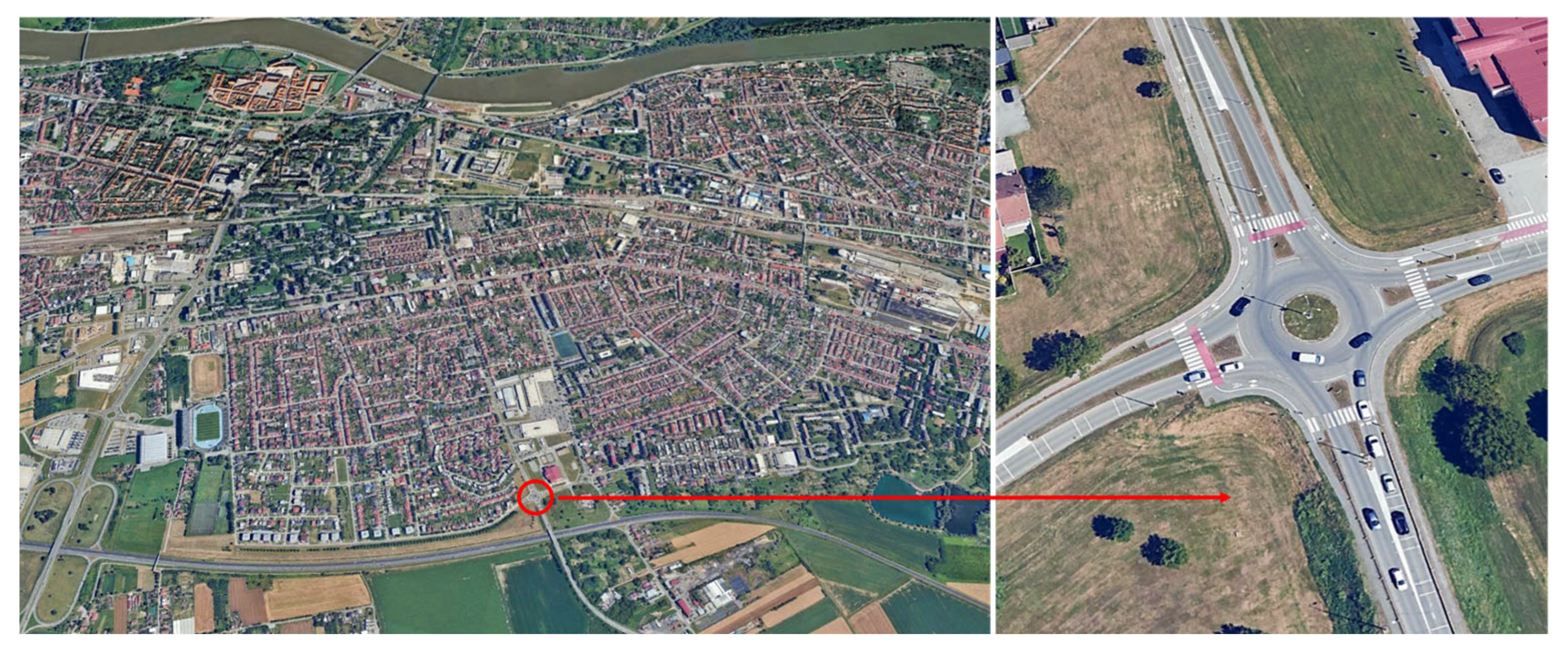

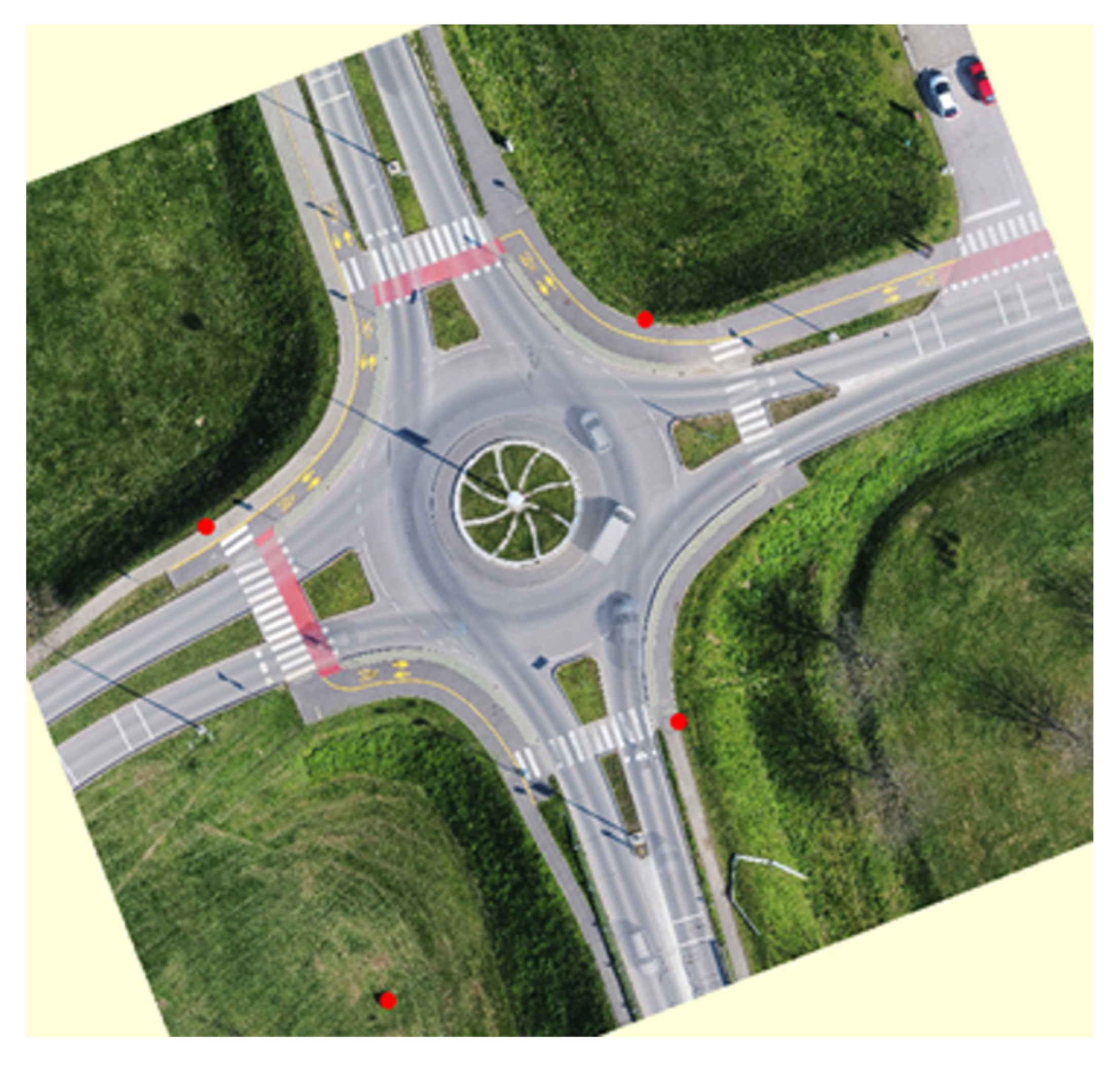
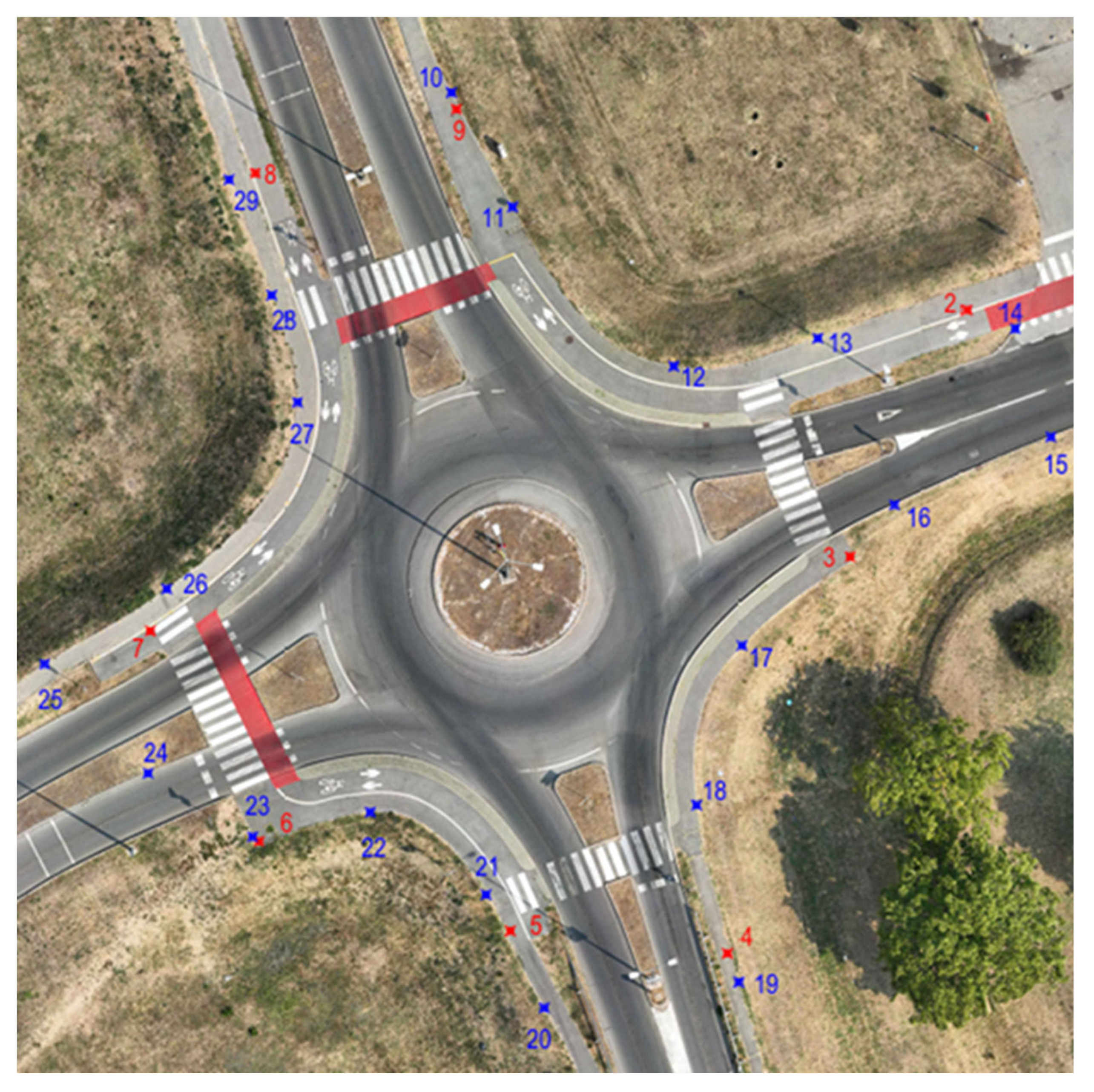
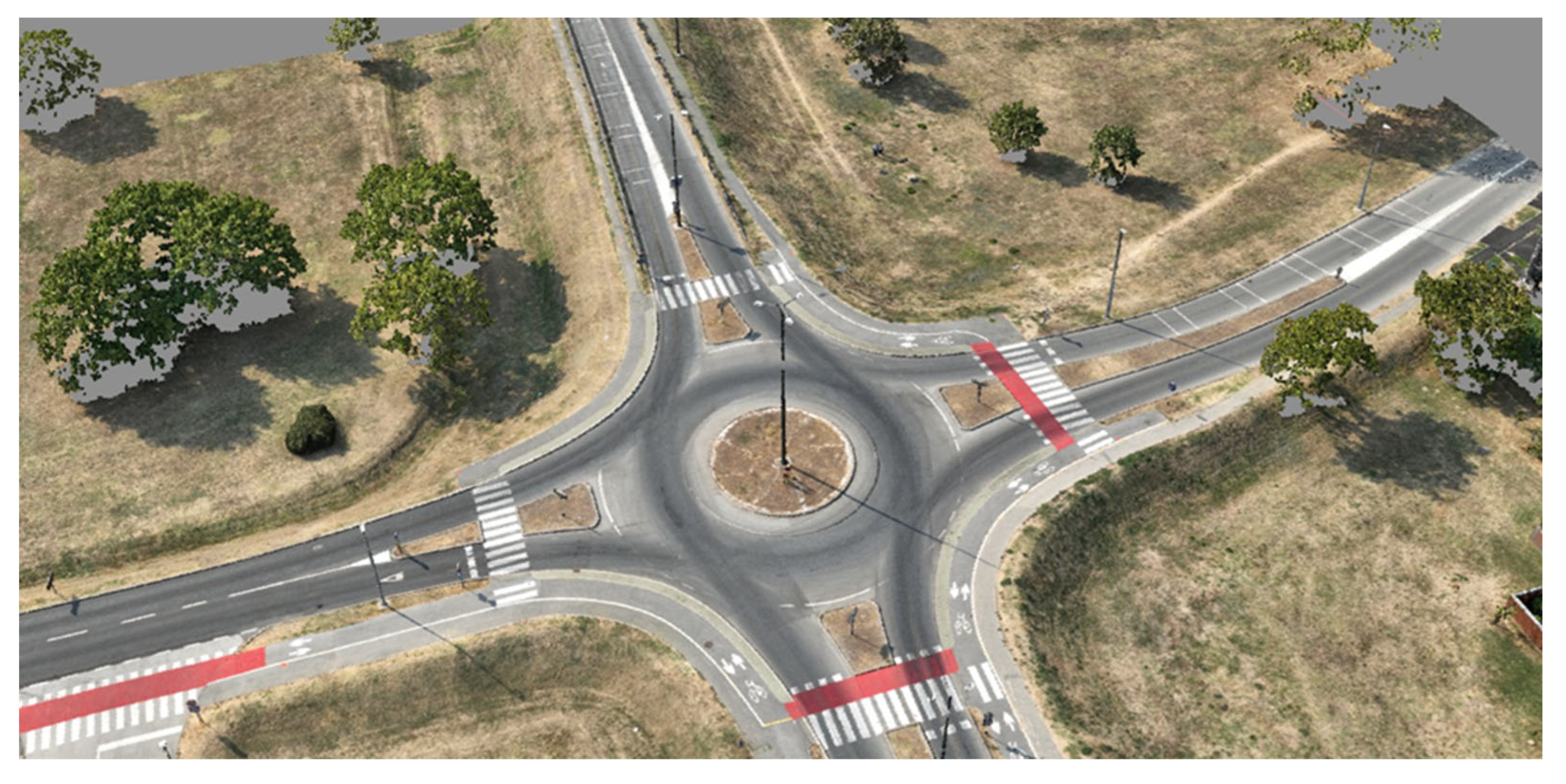

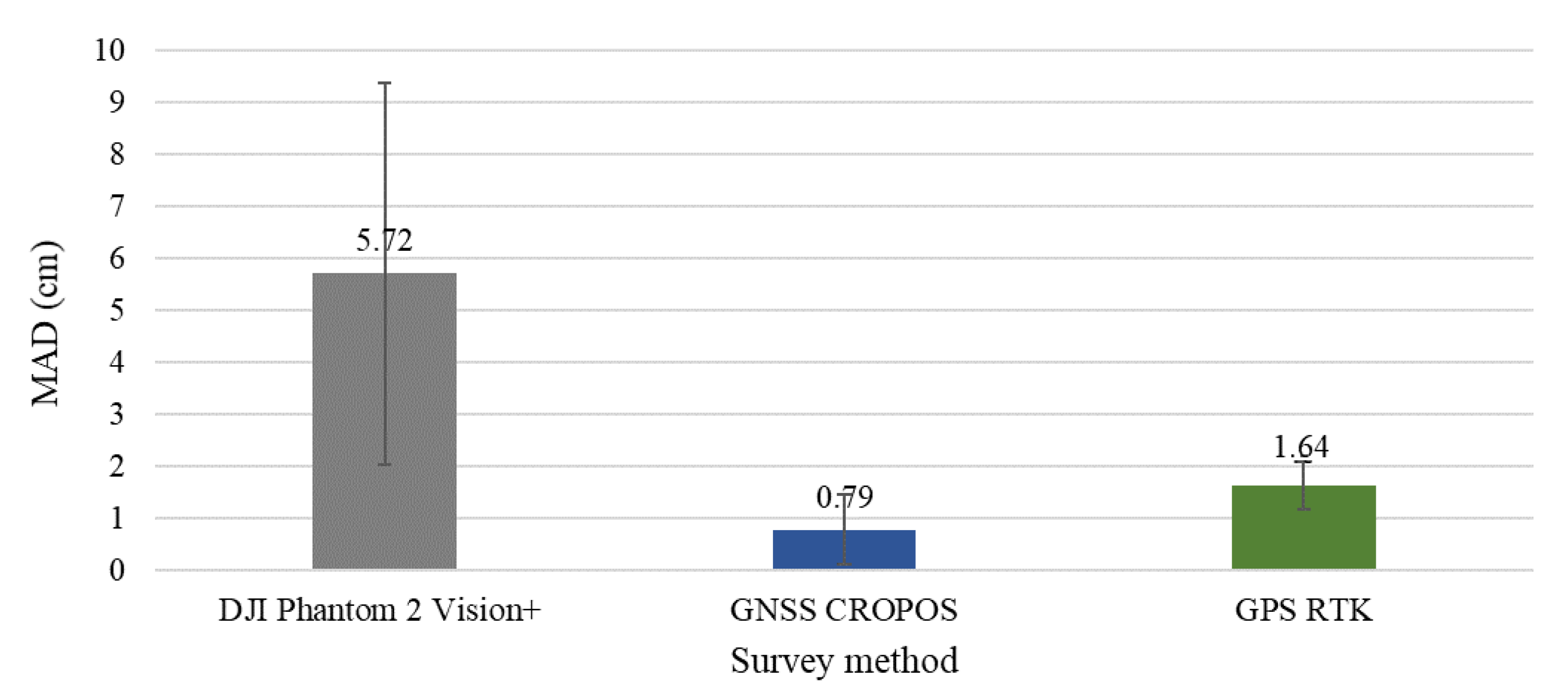
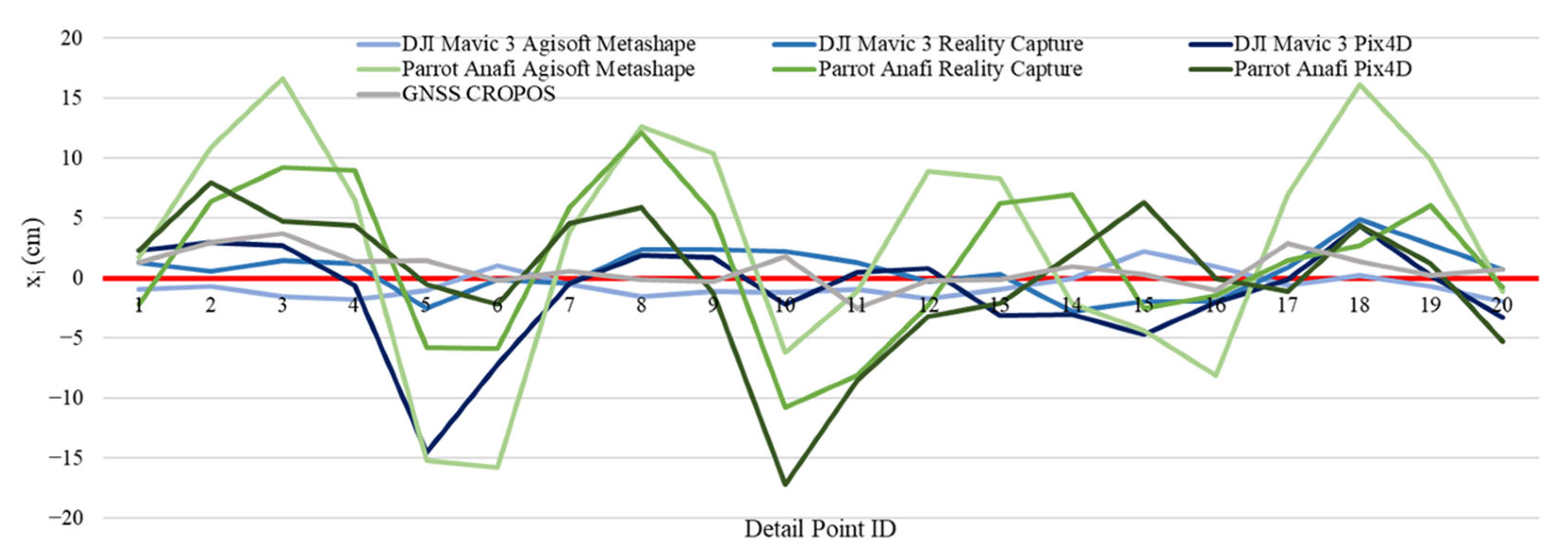

| UAV | SfM | Coordinate | RMSE | Reference Method | GCP | Year | Ref. |
|---|---|---|---|---|---|---|---|
| Phantom 3 Pro | Agisoft PhotoScan | x, y, z | ±16 cm, ±23 cm, ±48 cm | GPS | 6 | 2018 | [7] |
| Phantom 4 Pro | ContextCapture | horizontal, vertical | 0.88 cm, 0.38 cm | RTK GNSS | 3, 4 | 2021 | [8] |
| DJI Mavic Pro Platinum | Agisoft Metashape and Pix4dmapper | horizontal, vertical | 4–6 cm, 5–6 cm | RTK | 21 | 2021 | [9] |
| DJI M 300 | Agisoft Metashape | vertical | 21 cm | RTK GNSS | 16 | 2025 | [10] |
| DJI M 300 | Pix4dmapper | absolute | 1.1 cm | Laser RST | - | 2024 | [11] |
| Phantom 4 Pro | Agisoft Metashape | 3D | 1.72 cm to 7.61 cm | Total station | 10 | 2025 | [12] |
| DJI M 300 | Pix4D Mapper | x, y, z | ±2.66 cm, ±2.41 cm, ±3.47 cm | RTK GNSS | 14 | 2024 | [13] |
| Characteristic/UAV | DJI Phantom 2 Vision+ | DJI Mavic 3 Enterprise | Parrot Anafi |
|---|---|---|---|
| CMOS * (in) | 1/2.3 | 4/3 | 1/2.4 |
| Pixels (MP) | 14 | 20 | 21 |
| Aperture | f/2.8 | f/2.8 | f/2.4 |
| Max payload (g) | 1350 | 1050 | No payload, weight 320 g |
| Calculated Parameter | UAV | GNSS CROPOS | GPS RTK |
|---|---|---|---|
| MAD (cm) | 5.72 | 0.79 | 1.64 |
| RMSE (cm) | 6.78 | 1.04 | 1.70 |
| GNSS CROPOS | DJI Mavic 3 | Parrot Anafi | |||||
|---|---|---|---|---|---|---|---|
| Agisoft Metashape | Reality Capture | Pix4D | Agisoft Metashape | Reality Capture | Pix4D | ||
| MAD (cm) | 1.21 | 1.07 | 1.62 | 2.93 | 8.36 | 5.56 | 4.26 |
| RMSE | 1.61 | 1.20 | 1.98 | 4.31 | 9.74 | 6.41 | 5.70 |
| σ (cm) | 1.08 | 0.57 | 1.17 | 4.25 | 5.13 | 3.27 | 5.85 |
Disclaimer/Publisher’s Note: The statements, opinions and data contained in all publications are solely those of the individual author(s) and contributor(s) and not of MDPI and/or the editor(s). MDPI and/or the editor(s) disclaim responsibility for any injury to people or property resulting from any ideas, methods, instructions or products referred to in the content. |
© 2025 by the authors. Licensee MDPI, Basel, Switzerland. This article is an open access article distributed under the terms and conditions of the Creative Commons Attribution (CC BY) license (https://creativecommons.org/licenses/by/4.0/).
Share and Cite
Malić, B.; Moser, V.; Rajle, D.; Kulić, S.; Barišić, I. Comparative Assessment of Vertical Precision of Unmanned Aerial Vehicle-Based Geodetic Survey for Road Construction: A Multi-Platform and Multi-Software Approach. Infrastructures 2025, 10, 287. https://doi.org/10.3390/infrastructures10110287
Malić B, Moser V, Rajle D, Kulić S, Barišić I. Comparative Assessment of Vertical Precision of Unmanned Aerial Vehicle-Based Geodetic Survey for Road Construction: A Multi-Platform and Multi-Software Approach. Infrastructures. 2025; 10(11):287. https://doi.org/10.3390/infrastructures10110287
Chicago/Turabian StyleMalić, Brankica, Vladimir Moser, Damir Rajle, Saša Kulić, and Ivana Barišić. 2025. "Comparative Assessment of Vertical Precision of Unmanned Aerial Vehicle-Based Geodetic Survey for Road Construction: A Multi-Platform and Multi-Software Approach" Infrastructures 10, no. 11: 287. https://doi.org/10.3390/infrastructures10110287
APA StyleMalić, B., Moser, V., Rajle, D., Kulić, S., & Barišić, I. (2025). Comparative Assessment of Vertical Precision of Unmanned Aerial Vehicle-Based Geodetic Survey for Road Construction: A Multi-Platform and Multi-Software Approach. Infrastructures, 10(11), 287. https://doi.org/10.3390/infrastructures10110287






